What happens when your website isn’t converting visitors into customers, your pages have high bounce rates, or users are abandoning your checkout process? How do you uncover the reasons behind these challenges so you can fix them?
The answer lies in website feedback—the best way to understand user behavior and improve customer experience. It provides a window into the minds of your visitors, enabling you to identify frustrations, address specific pain points, and implement meaningful improvements.
By collecting user feedback directly from your site, you can gain valuable insights into design, navigation, content, and functionality. Whether through pop-up surveys, website widgets, popover surveys or feedback buttons, the right approach allows you to refine your survey strategy and meet user expectations. From improving conversion rate optimization on your landing pages to identifying user frustrations on a pricing page, feedback helps optimize every stage of the customer journey.
In this article, we’ll dive into everything you need to know about website feedback—from the best practices for crafting web surveys to the different types of website feedback tools and their use cases.
Whether you’re looking to implement a feedback widget, conduct usability testing, explore website survey questions, or gather contextual feedback, this blog will help you make smarter, user-driven decisions for your website.
TL;DR
-
Website feedback provides answers to crucial questions like how you can capture visitors' attention and encourage them to stay, or how you can convert them into customers.
-
Direct user feedback on the website unveils reasons behind issues like high bounce rate, such as navigation problems, unavailable products, insufficient information, and more.
-
Implementing website surveys and adding specific questions aimed to gauge different business goals such as improving marketing, post-purchase experience, or exit intent can further refine your website feedback strategies and enhance user engagement.
-
The different kinds of website feedback methods include website popup surveys, feedback button surveys, microsurveys, slide-outs, exit intent surveys, and embed and links surveys.
-
You can leverage in-site feedback to retain customers with NPS data, understand a post-transaction experience, get incomplete shopping cart data, or even receive web design feedback.
-
By adding website feedback button, pop-up surveys, conducting polls, or page-specific feedback, you can increase user participation rates in the website feedback surveys.
-
With Zonka Feedback, you can easily create website feedback surveys, measure feedback through different channels, and understand your customers better. You can book a demo to know more about the Zonka Feedback website feedback too.
Start Collecting Website Feedback Today
Collect actionable insights, create engaging web surveys, and analyze real-time data to boost conversions and user satisfaction.

What is Website Feedback?
Website feedback involves collecting user feedback both qualitative and quantitative, through a website survey containing open-ended questions and close-ended questions. The data is gathered firsthand from website users or visitors, through methods like on-page surveys, website polls, feedback widgets, link surveys, etc.
These valuable user or customer insights help you to understand user sentiments and thoughts concerning the website. Integrating this data with the best website feedback tools can help improve UX issues, heighten traffic, and enhance conversion rates for potential customers.
You can easily collect website feedback around anything from website design and products to customer support and loyalty with online survey tools.
Why is Website Feedback Important?
The importance of website feedback can be understood by looking at the following reasons:
-
Better participation rate: Customers often hesitate to open email surveys or SMS surveys. Offering feedback on the website, during their interaction, is more convenient and has a high response rate.
-
Feedback without contact details: Even if you do not have the contact details of your users, you can survey everyone visiting your website.
-
Feedback targeting: Surveys can be configured to target only the visitors who can provide genuine and valuable website feedback. For instance, a popup survey on design and navigation can trigger after specific page scrolls. Settings ensure surveys reach the right audience at the right time.
-
No sampling bias: While survey sampling methods may be reliable, they can still lead to sampling bias and overlooked feedback. Website feedback mitigates sampling errors by being accessible to all or specific visitors, enhancing feedback quality.
Website Feedback Questions to Ask Visitors
When collecting customer feedback on your website, asking the right question for the set purpose matters a lot. Let us look at the website feedback survey questions, when combined with website survey best practices can amplify your voice of the customer insights.
1. Website Survey Questions to Improve Marketing
Conducting market research can bring a lot of traffic to your website and promote your product. Here are a few questions that you can choose from for your website survey if your goal is to improve your marketing efforts and attract more visitors:
What brings you to our website today?
What made you choose us over other similar websites?
How did you hear about us?
2. Website Survey Questions Post Purchase
Once visitors make a transaction on your website, you can find out what makes your brand/website desirable and how you can improve it further through post purchase survey questions. Here are a few questions you may ask for measuring customer satisfaction post purchase:
What was the main reason behind your purchase/subscription today?
How would you rate your shopping experience?
Did you face any challenges while placing your order?
Do you have any questions about your purchase/subscription?
What did you like the most about your experience with our website?
What was the main concern or fear you had before purchasing?
Also Read: 9 Most Crucial Website Satisfaction Survey Questions
3. Website Survey Questions to Identify Exit Intent
When visitors are about to leave your website without making a purchase, signing up for the newsletter, or requesting a quote, you can ask for their feedback with an exit intent survey. It would allow you to understand what you can improve to increase the conversion rate on your website. Here are some exit intent survey questions that you can ask:
We are sorry to see you go. What can we do to help you complete your purchase?
What stopped you from making a purchase today?
Was there anything specifically that made you exit from the page?
What stopped you from signing up?
Which of these following can we improve to help you make a purchase? (Give options like website design, product availability, payment mode, etc.)
Is there something keeping you from [completing your purchase/signing up for a free trial]?
What can we do to improve our website?
Were you looking for anything today that you could not find?
4. General Website Survey Questions
Many times, your website visitors will leave feedback that may tell you about problems that may have gone unnoticed previously and can improve your website dramatically. Here are some website usability survey questions that can help you gauge feedback like website design feedback, product feedback, etc.:
What did you like/dislike about our website?
On a scale of 1-10, how likely are you to recommend our website to others? (Ask a follow-up question to prompt visitors to share the reason for their score.)
How would you rate our website on a scale of 1 to 10?
Do you have any suggestions that can help us improve our website/offerings?
Best Practices for Creating Website Feedback Surveys
For creating a good website feedback form, you don't have to be an expert or need any technical know-how. Even a novice can create, distribute, and analyze website feedback by following some tips and tricks. Here are some best tips that help you to build the best surveys possible.
-
Keep your survey short and straightforward and avoid leading questions that can mislead your audience.
-
Optimize your website survey for different devices including mobile, iPad, and Android tablets.
-
Provide an open-ended question so respondents can elaborate on their issues and express their opinions through sentences, records, and stories.
-
Reduce the frequency of surveys to prevent overwhelming your visitors with excessive survey appearances, which can lead to survey fatigue.
-
Test your survey before sending it live on the website by sharing it with your colleagues and telling them to spot as many errors as they can. Survey Test helps you to identify the issues and fix them quickly to improve surveys before they go live.
Types of Website Feedback
Feedback can be collected in different ways so that you can gather valuable insights directly from users and make informed decisions to enhance websites and user experiences. Here are some common sources of website feedback.
1. Website Popup Survey
A website popup survey, as the name suggests, appears on the website inside a popup and immediately captures visitors’ attention which increases the survey participation rate. They can also be targeted towards a specific set of visitors based on their interactions with the website, for example, a customer satisfaction survey popup post-purchase.
However, popups may annoy some visitors. So, make sure to keep the survey short with one or two multiple-choice questions and a follow-up open-ended question to allow visitors to share the reason for their answers.
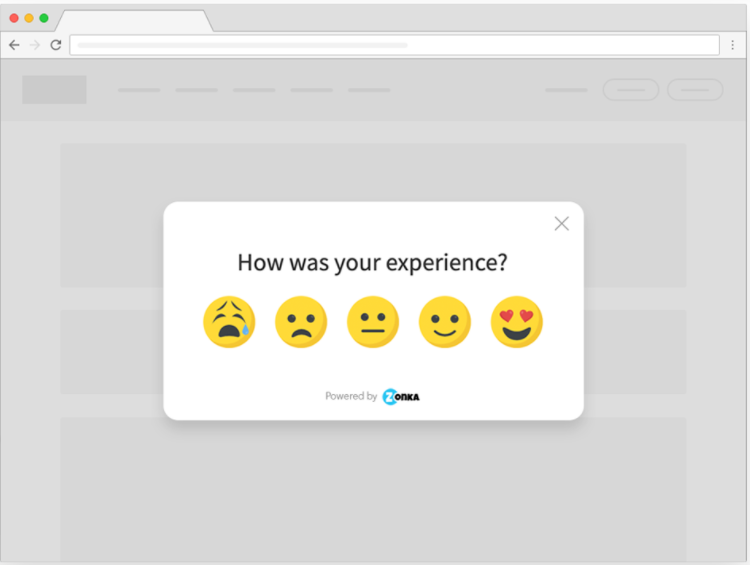
2. Website Feedback Button Survey
A website feedback button survey consists of a button that visitors can click to open a survey that overlays the screen. It encourages unsolicited feedback since visitors usually click on it only when they have valuable feedback to share.
A feedback button is simple and clutter-free, which makes it a great feedback choice for minimal websites.
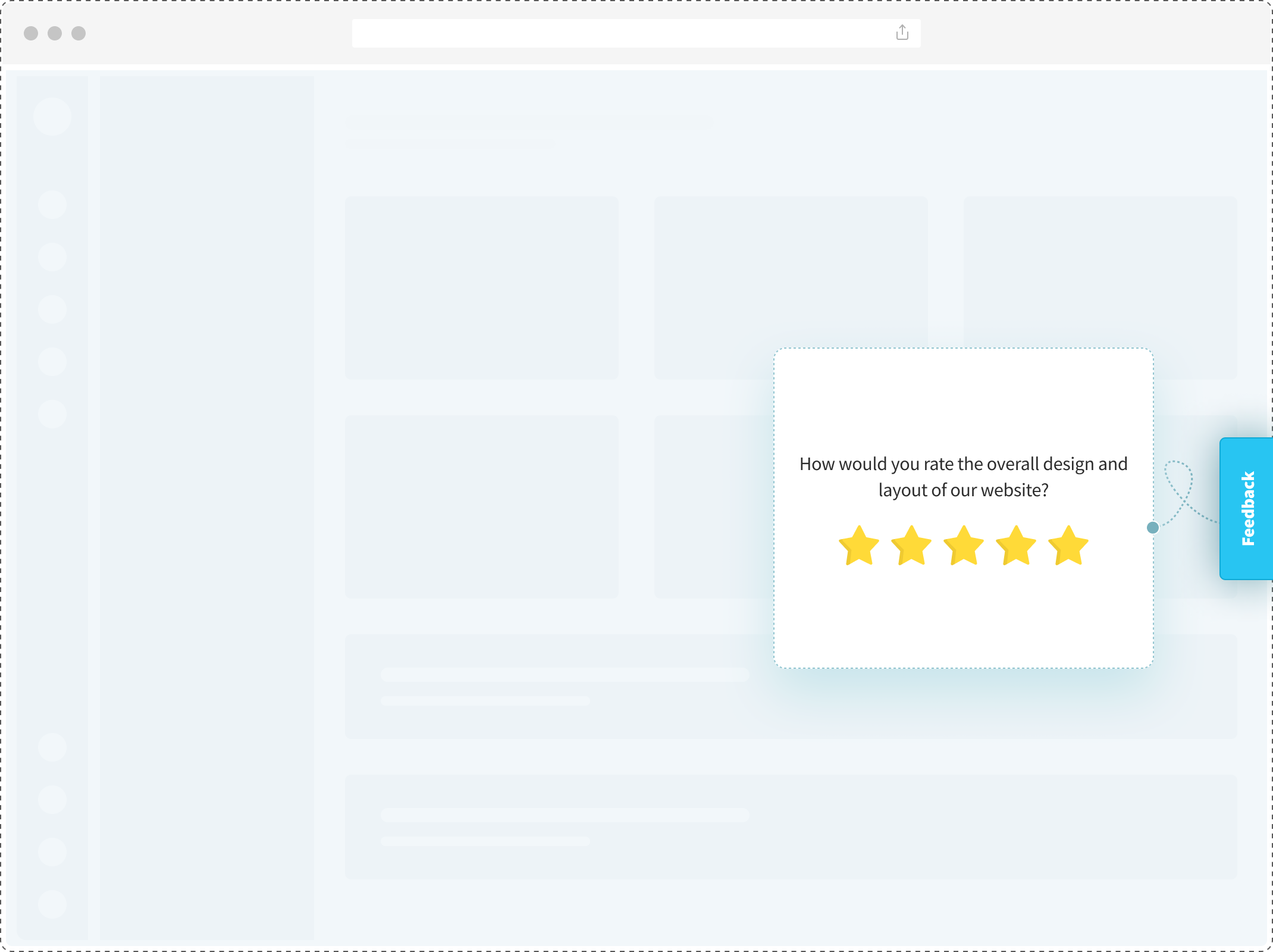
3. Microsurveys
Microsurveys are short surveys that can be added to your website to collect feedback effortlessly which increases the response rate significantly. Strategically placed at various touchpoints, these Microsurveys ensure continuous accessibility, effectively capturing feedback whenever needed without burdening users.
The main types of Microsurveys are:
Net Promoter Score Surveys
A Net Promoter Score Survey allows customers to rate their loyalty to the brand by asking if they would be willing to recommend your business to others. A Net Promoter Score survey question can be answered on a 0 to 10 or 1 to 10 opinion scale surveys, where 0 may mean ‘least likely to recommend’ and 10 may mean ‘most likely to recommend’.
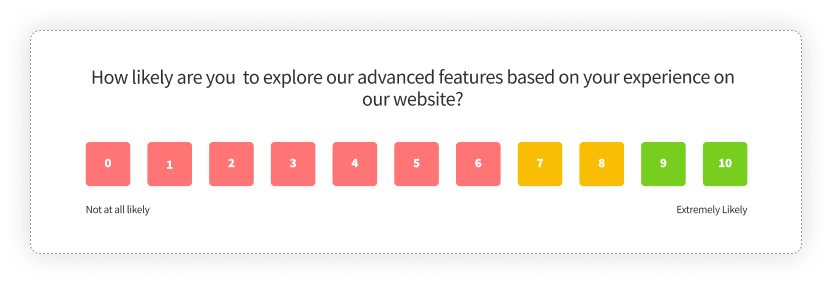
Customer Satisfaction Surveys
A customer satisfaction survey captures customers’ satisfaction levels after a purchase or transaction. It consists of a question with answer choices from very dissatisfied to very satisfied. For example, a CSAT survey can be added to the order confirmation page and may prompt customers to share their satisfaction levels after a shopping experience.
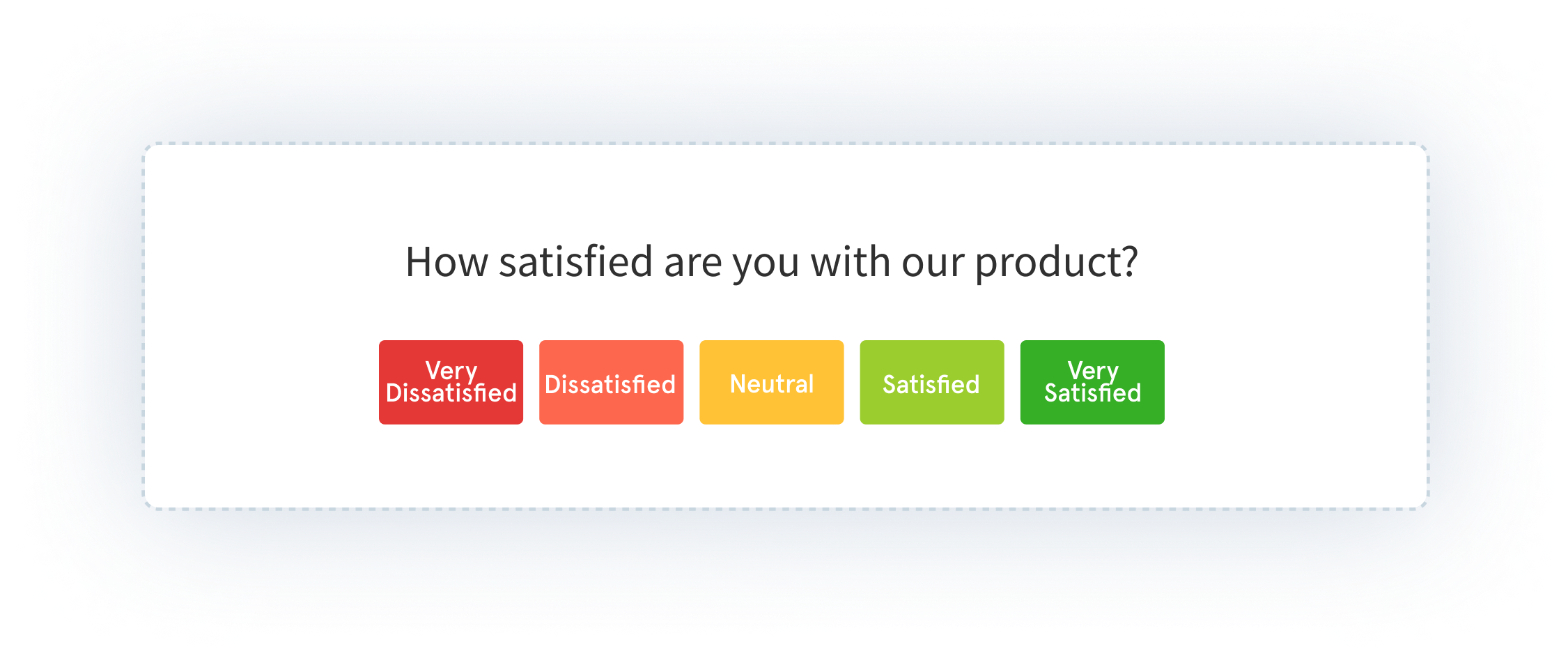
4. Slide Up & Bottom bar Survey
A slide up survey appears from the bottom of the web page as an overlay. They can be set to appear based on user activity or time, like post transaction, visiting a new page, or after the user spends some time or browses a particular percentage of the web page.
Similarly, bottom bar surveys are buttons that can be placed on the bottom right or left side of your web page that open the survey on click.
These are great for collecting generic feedback in terms of the website content, design, product quality or availability, or shopping experience; what matters is their placement, i.e., the web page they are added to.
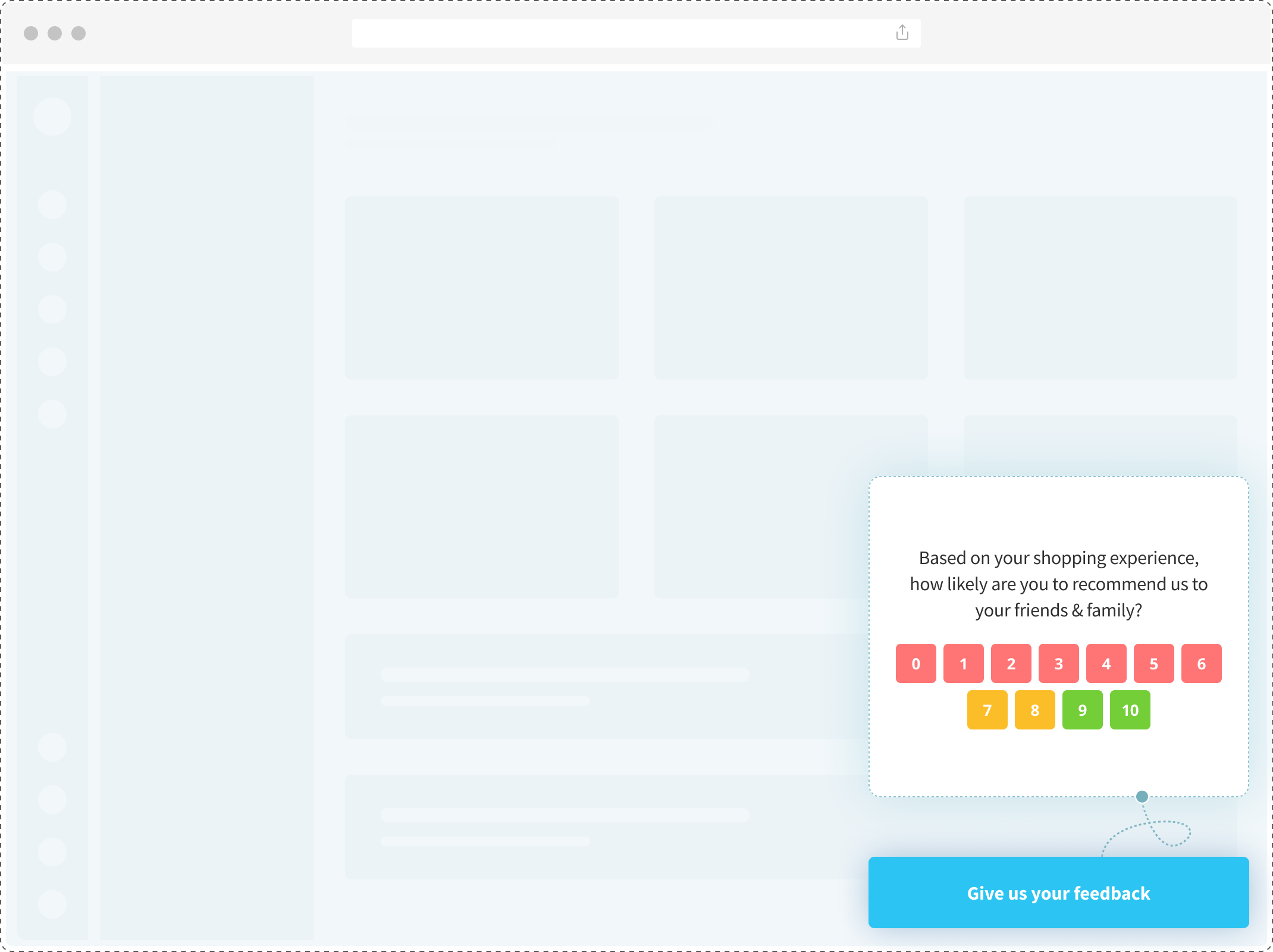
5. Exit Intent Surveys
Website exit intent surveys pop up on the screen when visitors are about to exit your website without making a transaction. They pop up when the website visitor moves towards the upper side of the browser or the ‘close’ button.
The survey is aimed at understanding why visitors leave early or without completing a transaction. This information can help brands make the right efforts to increase conversions and customer satisfaction.
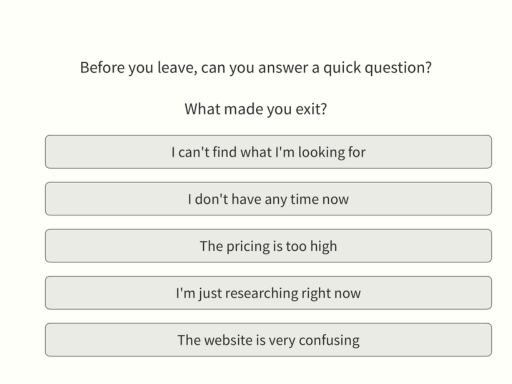
6. Embed and Link Surveys
Website embed surveys or inline surveys are static surveys that are added directly to your website. This means that the survey would be a part of your website and all your visitors can see it. A good example would be a simple rating scale survey at the end of a blog post, asking readers to rate how helpful they find the information in the blog.
Similarly, link surveys can be added anywhere among the website content (for example, blogs and interactive landing pages) and allow visitors to click on the link and take surveys relevant to the content they may be browsing through.
Website Feedback Use Cases
Website feedback data can be collected for various reasons as we have been suggesting throughout. Let us look at the specific use cases where website feedback can be extremely useful.
1. To Get Post-Transaction/Experience Feedback
You can survey your online customers as soon as they make a transaction. For example, when a customer places an order, they can be prompted to share their experience through popup survey questions set to trigger on the order confirmation page. Similarly, visitors can be asked to rate their experience with the website after they sign up for a newsletter or buy a subscription.
2. To Get Abandoned Shopping Cart Data
By surveying customers who abandon their cart using an exit survey when they are looking to leave your website, you can identify the reasons for cart abandonment that are preventing the visitors from completing their transactions on your website. You can uncover underlying issues, such as the unavailability of certain products, poor interface, unavailability of a certain mode of payment, etc., and resolve them so that potential visitors can have a seamless experience whether you have a new website or established brand presence.
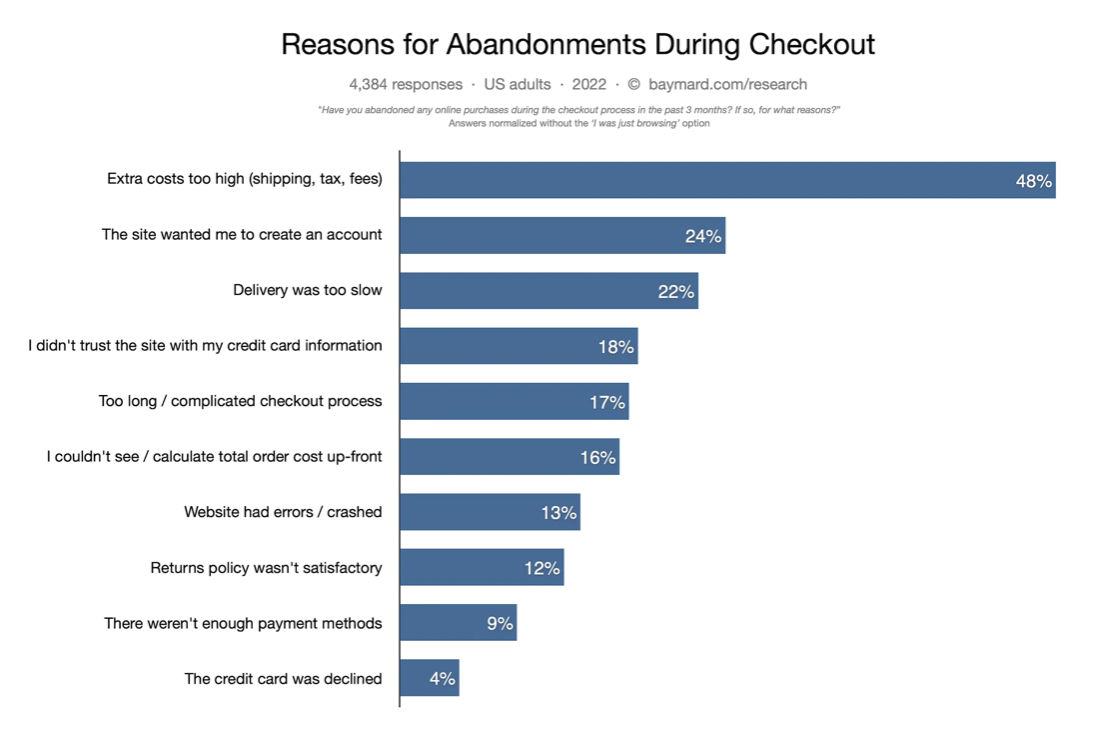
3. To Retain Customers with NPS Data
You can use your website NPS survey to capture feedback in real-time across various customer touchpoints. For example, you can set the NPS survey questions to be triggered as soon as you have a business interaction with a visitor. This way, when customers interact, they can share their perception of your brand based on the interaction in real-time right on your home page or through a live chat survey.
4. To Receive Website Design Feedback
Website surveys can help you improve your website dramatically by asking visitors to rate your website in terms of navigation, design, content, and usability. And with different survey options available, you can ensure that feedback is relevant and helpful. For example, you can set the website survey to be triggered once the visitor has gone through a specified number of web pages or a specified percentage of the page.
5. To Receive Post-Resolution Feedback
When you’re offering customer support through live chat, you can ask for feedback immediately using live chat surveys. For example, if you have just resolved a customer ticket and updated the customer about the resolution via chat, you can survey them by asking if they found the support helpful. You can ask for feedback from customers to rate the support in terms of agents’ willingness to help, quick response, knowledge, and resolution.
Creative Ways to Collect Feedback on Website
Let us look at some tried and tested website survey strategies to help you get the most out of website surveys.
1. Use Popup Surveys to Get your Users' Attention
Your website users and customers may easily fail to notice a boring survey sitting at the bottom of your web page. Moreover, depending on where you choose to position your surveys, your users may not even reach the point of sharing feedback on the website.
To prevent this, capture your users' attention and receive feedback immediately through survey collection methods like website popup surveys and increase the chances of users sharing feedback.
For instance, if users frequently exit your site without transactions, they're unlikely to stay for giving a website feedback. You can then show an exit survey to intercept them before leaving, allowing you to understand their reasons for leaving. This feedback helps understand high bounce rates and informs strategies to enhance conversion rates effectively.
Keep in mind these points while designing a website popup survey:
-
Make sure that the survey should be displayed to returning visitors and the pop-up should appear after viewing 2 or more pages.
-
Keep the survey questions short to encourage people to fill out more.
-
Make use of both open and close-ended questions.

2. Add a Feedback Button for Website Design & Usability Feedback
According to Top Design Firms, 50% of the users consider web design important for the overall brand image. There are many elements that impact how your website and brand are perceived. For example, the website theme, the load time, mobile responsiveness, easy navigation, etc. The key is to find out what matters to your audience through their feedback on website.
This can be done with one of the most effective website feedback widgets - a feedback button. You can insert this feedback widget anywhere on your website to collect generic or specific feedback.

Why Use a Feedback Button to Collect Feedback on your Website?
-
Doesn't clutter the website
-
Doesn't interrupt the users
-
Encourages unsolicited feedback
-
Communicates the value of customer feedback for the brand
3. Use Quick Polls for Content & Help Article Feedback
Polls are one of the quickest and most effective ways to collect customer feedback on the website. There are numerous customer feedback tools available that will allow you to input questions and multiple response options in the direct feedback form of online polls that can be integrated into your website.
Also Read: Top 55 Voice of Customer Survey Tools
You can utilize website feedback polls to:
-
Capturing instant feedback from users
-
Understand what products or features users want the most.
-
Determine visitor intent on why users are on your site and their goals.
-
Understand content relevance or help article usefulness (through the Thumbs Up and Thumbs Down survey at the end of the blog post)

4. Collect Cart Abandonment Feedback
Cart abandonment surveys are popups consisting of short surveys aimed at understanding why visitors abandon their shopping carts and exit without making a transaction. The survey is triggered right when customers move towards the exit button instead of clicking on ‘Place Order' after adding items to the cart.
Depending on your business goals, you can uncover insights like:
-
What would help customers complete their transactions or place an order?
-
What are the primary reasons potential customers or subscribers quit before making the transaction?
-
How you can help or assist them with additional information to improve their website experience?
.png?width=1112&name=frame_generic_light%20(5).png)
5. Collect Page-Specific Feedback
Page-specific feedback helps to collect website feedback from users on a specific page of a website. It involves creating targeted surveys or feedback mechanisms that are tailored to the content, purpose, or customer journey of that particular webpage.
This approach enables you to gather insights directly related to the functionality of a specific page. For example, embedding a product survey on the product pages.

Why embed page-specific surveys on your website?
-
To get targeted insights related to specific pages' content or functionality.
-
Understand user sentiments and improve pages accordingly.
-
For an informed optimization of pages based on user's interactions.
6. Collect Screenshot and Video Feedback for Bug Report
To get feedback on bugs or errors, you cannot expect your visitors to make the effort to take a screenshot of the same page, find your business email address, and report the bug. The customer effort score needs to be low so that users are encouraged to give bug reports on a live website. You can select a website feedback tool that helps you identify bugs through visitors in two ways:
-
Screenshot Feedback: Reliable visual feedback tools help to capture bugs visually by enabling users to take screenshots with comments and share them without leaving the website.
-
Video Feedback: Monitor user sessions like incomplete purchases or product searches through short videos to uncover issues leading to poor website experiences.
7. Use Website Surveys for User Research and Segmentation
Website surveys play a crucial role in understanding your audience better. For instance, if you're operating an e-commerce website, you can gather user details such as gender, preferred brands, style, etc. This information is valuable for user segmentation and creating buyer personas.
By doing so, you can craft highly targeted advertisements, personalized recommendations, and email campaigns that resonate with specific segments of your audience, ultimately enhancing user engagement and conversions.
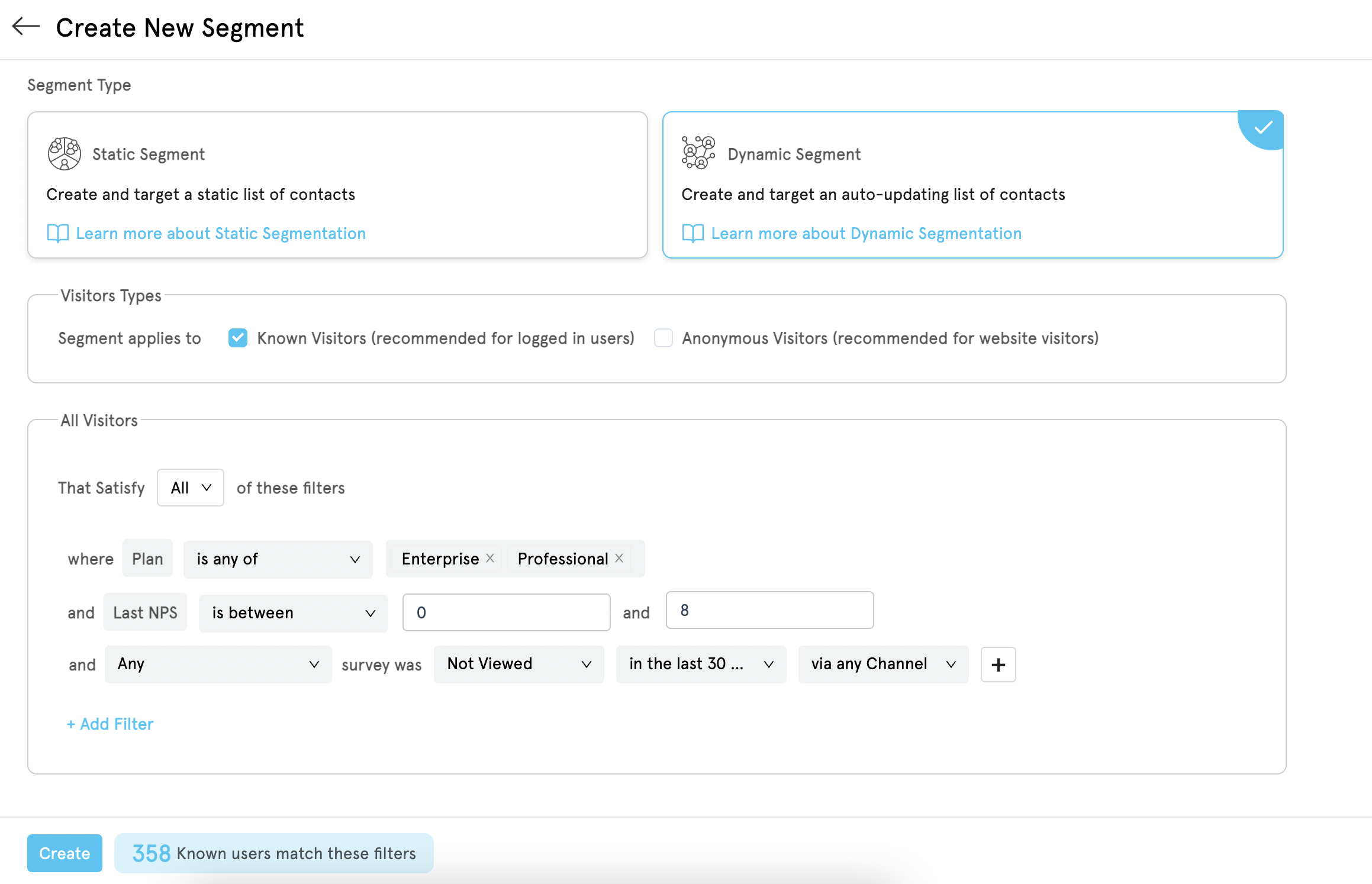
8. Collect Feedback in Chatbot and Livechat
The live chat option is helpful in answering your customers' questions by providing them with relevant information. It will also help your customers locate any missing items or answer their queries related to availability, payment, shipping, etc.
Your chatbot can do more than just help users. You can use the chat option to collect relevant feedback on website in terms of FAQs, the customer experience, support feedback, agent performance, etc. This can be done simply by integrating survey software with your chat tool.
Additional reasons to collect feedback using chatbot and livechat include:
-
Collect real-time feedback from website visitors through website visitor experience survey questions, making it convenient to capture their thoughts and feedback at the moment.
-
Users can ask for clarifications or provide more context, ensuring accurate customer feedback collection.
-
Interacting with a chatbot or live chat can be more engaging than filling out a traditional feedback form, leading to higher response rates.
9. Monitor User Behavior Using Web Analytics
You may not always find what you're looking for if you only use surveys to collect feedback directly on website since it is subject to user participation. But to understand how users engage with your brand through the website, you can monitor website analytics. This can help you understand several factors to see how your website is performing, such as:
-
Which pages are performing well
-
Which page do users usually exit the website at
-
Top blogs or resources that can improve conversions
-
Session duration
-
The number of pages users visit in a single session, etc.

10. Encourage Feedback with Incentives
Often, users refrain from investing their time and effort in sharing feedback with brands, especially if there is no incentive for them. And this can be a major roadblock in your website feedback strategy.
To encourage more participation, you can offer your visitors incentives such as:
-
Discounts or coupon codes for completing a feedback survey, encourage users to provide feedback.
-
Access to exclusive content, such as e-books, whitepapers, or webinars, or early access to new features or products in exchange for feedback.
-
Free trials of premium services or products in exchange for feedback.
-
Points or rewards where users earn points for each feedback submission, which can be redeemed for rewards.
-
Customized offers or recommendations based on customer feedback provided, showing users their opinions matter.
-
Pledge donations to a charity or cause for each completed feedback form, giving users a sense of contributing to a greater good.
Turn Feedback into Action with Zonka Feedback
Website feedback is a cornerstone for improving user experience, enhancing customer satisfaction, and driving business growth. It allows you to dive deep into user behavior, uncover key pain points, and implement meaningful changes that resonate with your audience. Whether it’s resolving navigation issues, refining checkout processes, or optimizing your website’s content, actionable feedback helps you make smarter, data-driven decisions.
With Zonka Feedback, transforming insights into impactful action is seamless. Take advantage of customizable surveys, interactive feedback widgets, and advanced analytics to gain a 360-degree view of your users’ needs and behaviors.
Collect feedback effortlessly at key website touchpoints using diverse survey types, including pop-ups, feedback buttons, and embedded forms. Harness features like survey logic and branching for personalized questions, user segmentation for targeted insights, and workflow automation to streamline processes. Seamless integrations with tools like Google Analytics, Salesforce, and Slack further enhance your ability to analyze and act on data efficiently.
Zonka Feedback doesn’t just collect feedback—it empowers you to close the feedback loop, foster customer-centric improvements, and drive meaningful business growth.
Ready to elevate your website experience? Schedule a demo today and see how Zonka Feedback can turn your website into an engagement powerhouse!
FAQs
1. What is website feedback?
Website feedback involves collecting insights, opinions, and suggestions from website visitors or users to improve aspects like design, navigation, content, and functionality. By using the right website feedback tool, you can gather actionable data to enhance user experience and meet business goals effectively.
2. How can website feedback improve user experience?
Website feedback helps identify and address pain points such as:
-
Navigation difficulties or confusing layouts.
-
Insufficient product or service information.
-
Slow loading times or technical glitches.
By acting on this feedback, businesses can optimize the website for better usability and higher engagement.
3. When is the best time to collect website feedback?
Timing depends on your goals:
-
Post-purchase: Right after a transaction to assess satisfaction.
-
Exit intent: When a visitor is about to leave the site.
-
During interactions: While using live chat or browsing a product page.
-
Post-engagement: After downloading a resource or signing up.
4. Where should I place website feedback surveys?
Surveys can be strategically placed on checkout pages, product pages, pricing pages, landing pages, and even the homepage to gather context-specific feedback and improve key user touchpoints.
5. Will asking for feedback impact user experience or lower engagement on my website?
When implemented with care, feedback collection enhances user experience instead of disrupting it. Use unobtrusive methods like feedback buttons, slide-ins, or website feedback forms, and ensure surveys are concise and relevant. Providing an easy option to dismiss the survey prevents frustration and encourages participation.
6. What can be done to encourage users to share honest and valuable feedback?
Transparency and simplicity are key. Keep surveys anonymous to reduce hesitation, and clearly explain how feedback will improve their experience. Using visual feedback tools can make the process more interactive and engaging.











